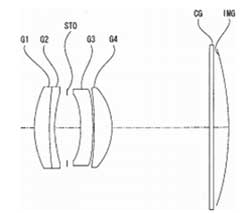Sony last week demonstrated its new curved image sensor technology at the VLSI (Very Large Scale Integration) Symposium in Hawaii, showing a full-frame and 2/3-inch version of sensors which offer better signal-to-noise ratio, greater overall sensitivity, and the potential for simpler and smaller lenses.

It’s been speculated in the technology press that working cameras incorporating the new sensor technology are not too far from becoming a reality, and last year Sony also patented a simple f1.8, four element-in-three group 35mm lens to match the curved sensor, along with several other lenses.
A curved sensor mimics the shape of the human eye. According to Sony its curved CMOS BSI sensor and an integrated lens will deliver close to zero light loss in the corner of the images and create a great deal less curvature aberration. It will also be capable of richer blacks.

Sony explains its breakthrough thus:
We realized an ultimately advanced imaging system that comprises a curved, back-illuminated CMOS image sensor (BIS) and integrated lens, which doubles the sensitivity at the edge of the image circle and increases the sensitivity at the centre of the image circle by a factor of 1.4 with one-fifth lower dark current than that of a planar BIS.
Because the lens field curvature aberration was overcome in principle by the curved sensor itself, the curved BIS enables higher system sensitivity through design of a brighter lens with a smaller f number than is possible with a planar BIS. At the same time, we controlled the tensile stress of the BIS chip to produce a curved shape that widens the energy band-gap to obtain a lower dark current. The curved CIS can be applied to an ultimately advanced imaging system that is validated by the evolution of the animal eye in Nature.
Existing interchangeable lenses would not be compatible with curved sensors, so it’s likely the first cameras using the technology will be in smartphones, and fixed lens cameras.
According to website Image Sensors World, Sony device manager Kazuichiro Itonaga told the Symposium: ‘The team has made somewhere in the vicinity of 100 full-size sensors…We are ready.’
– Perhaps we will see at least a prototype of a working curved sensor camera at Photokina?





Be First to Comment